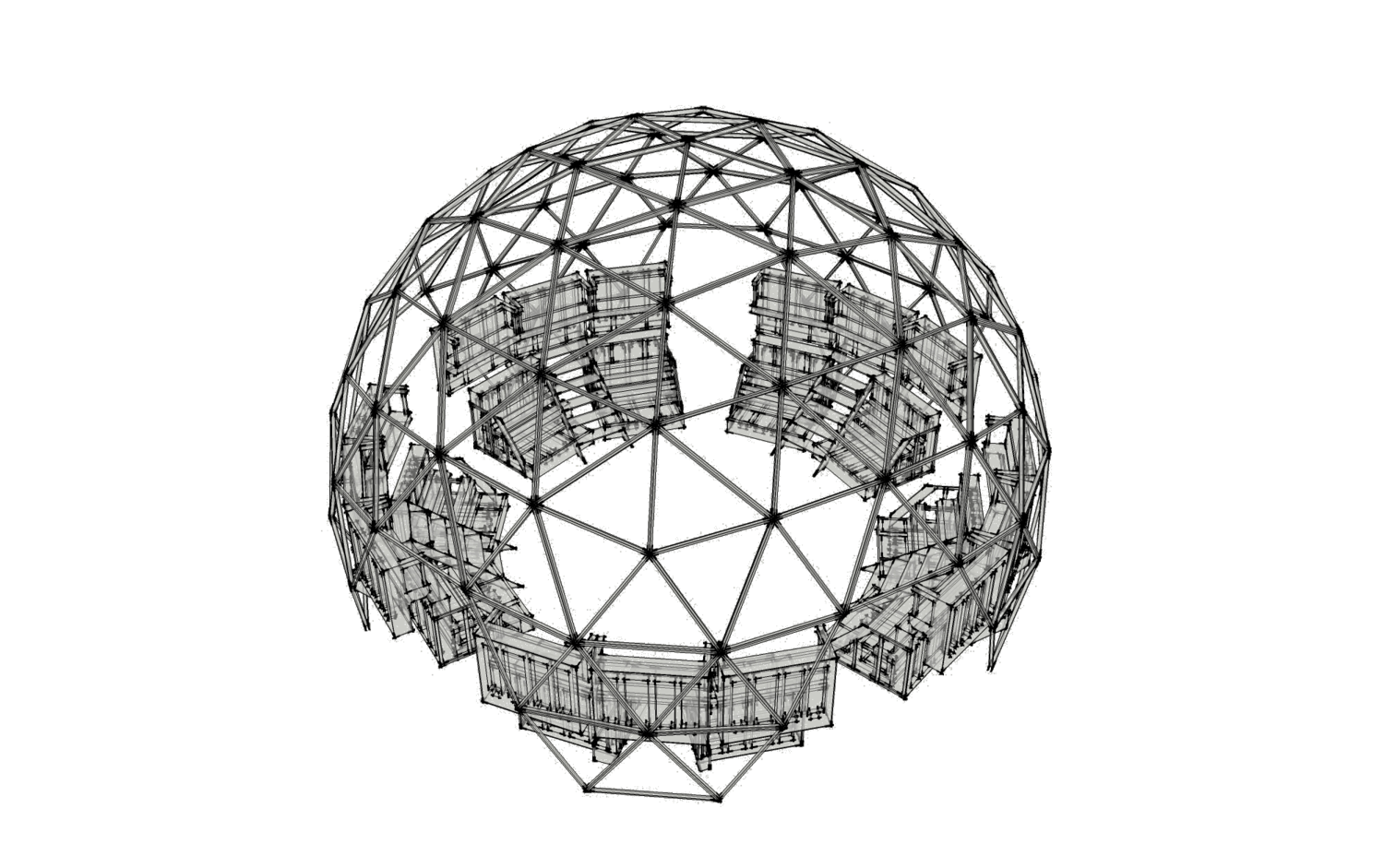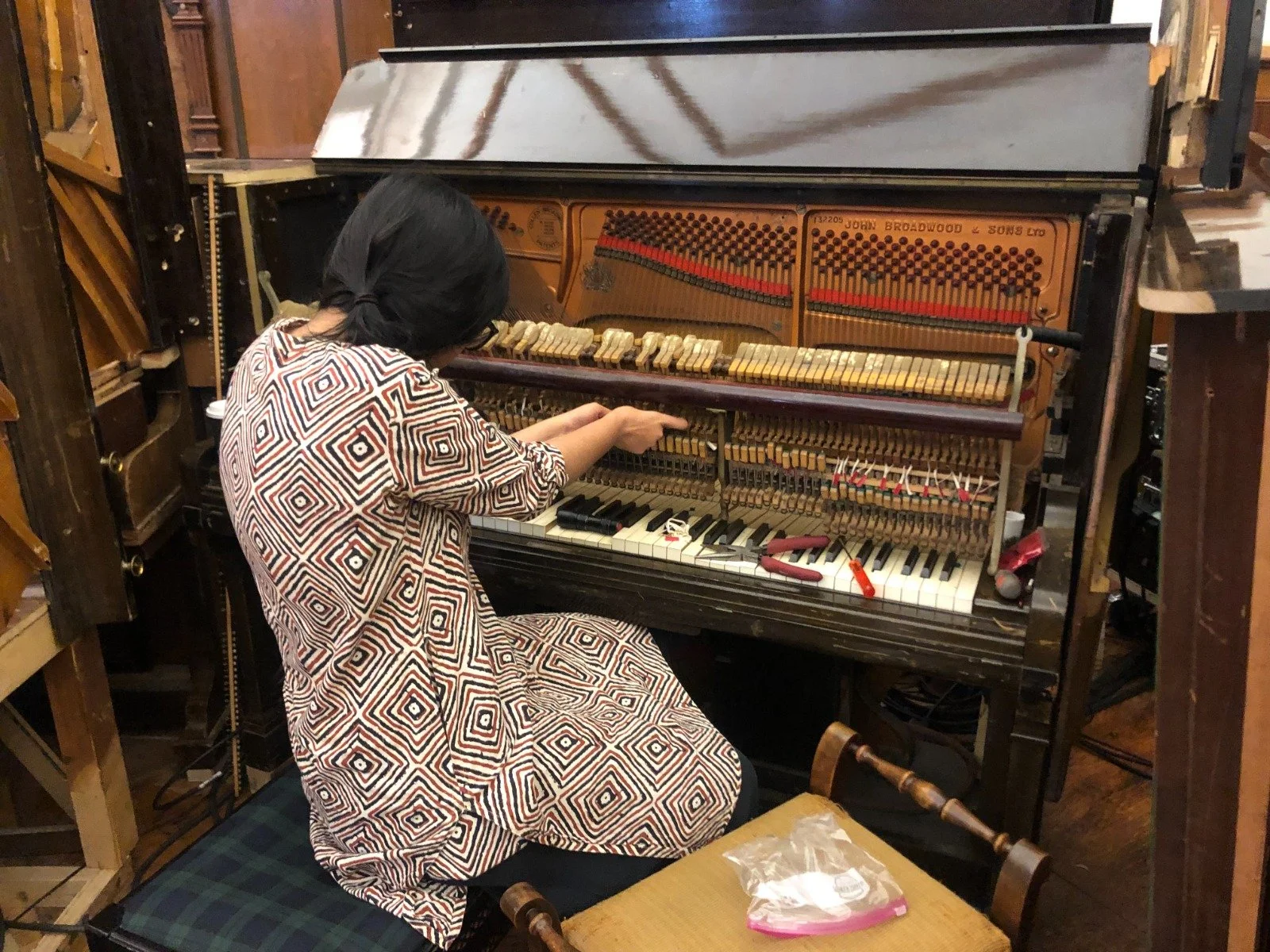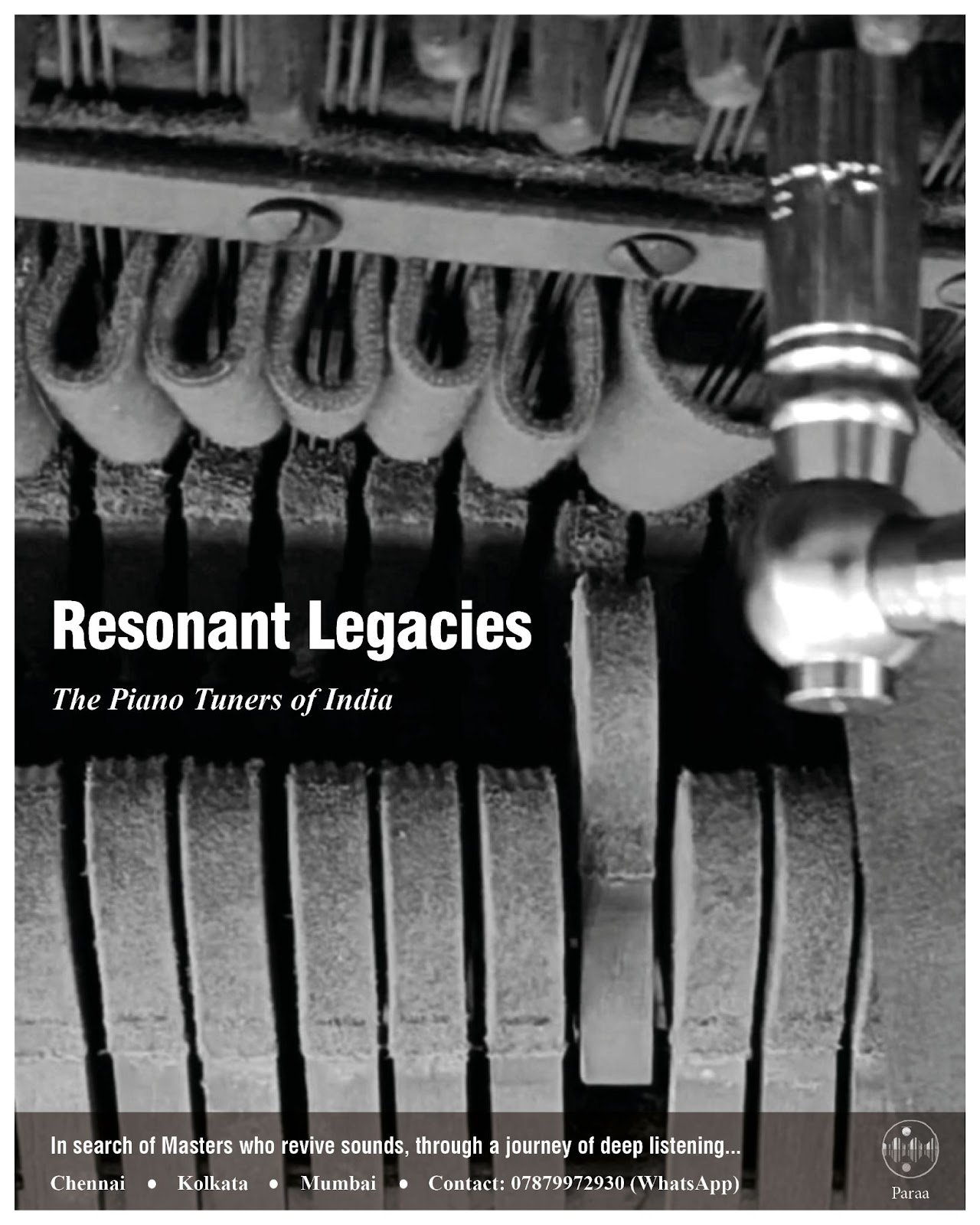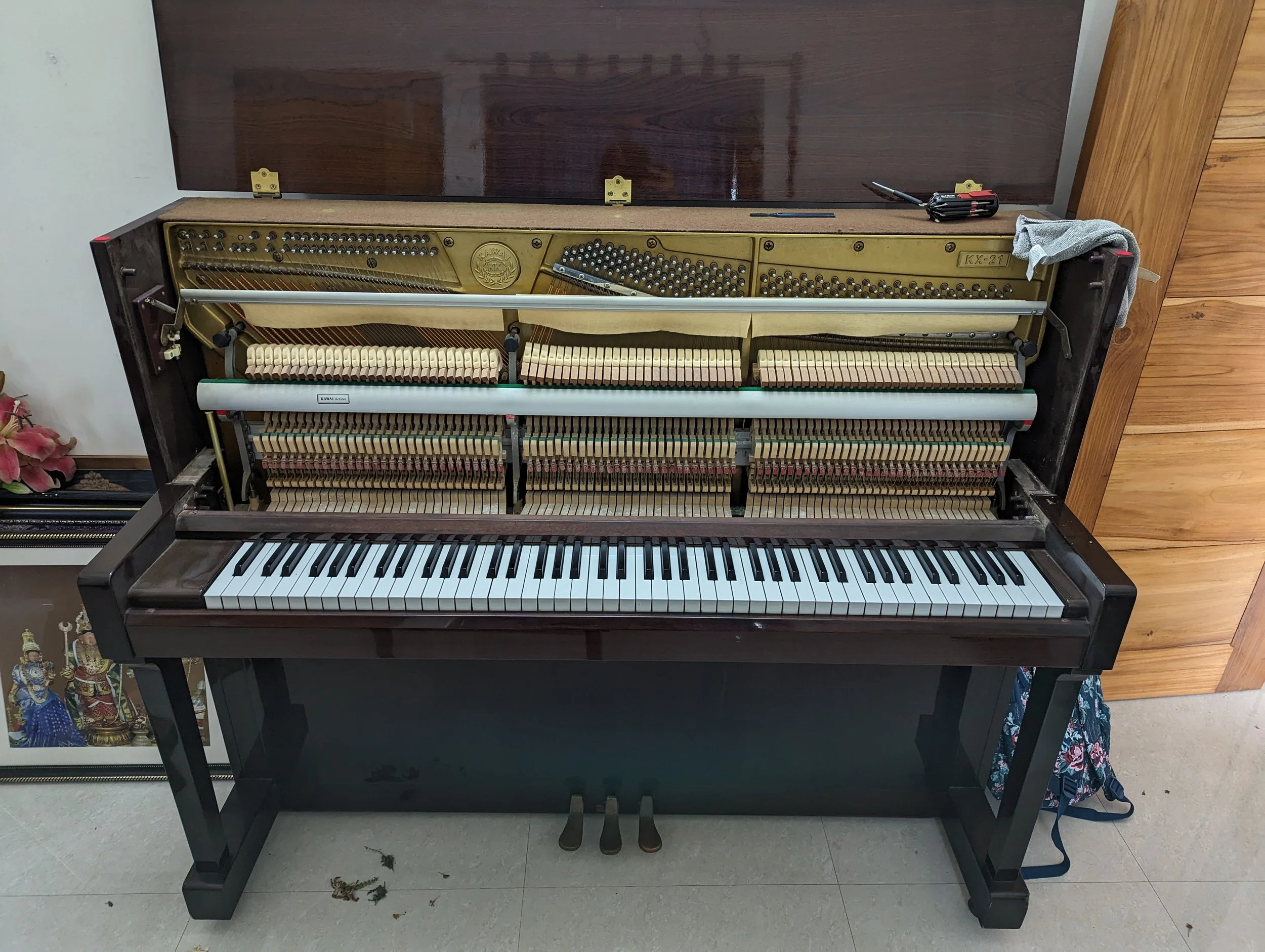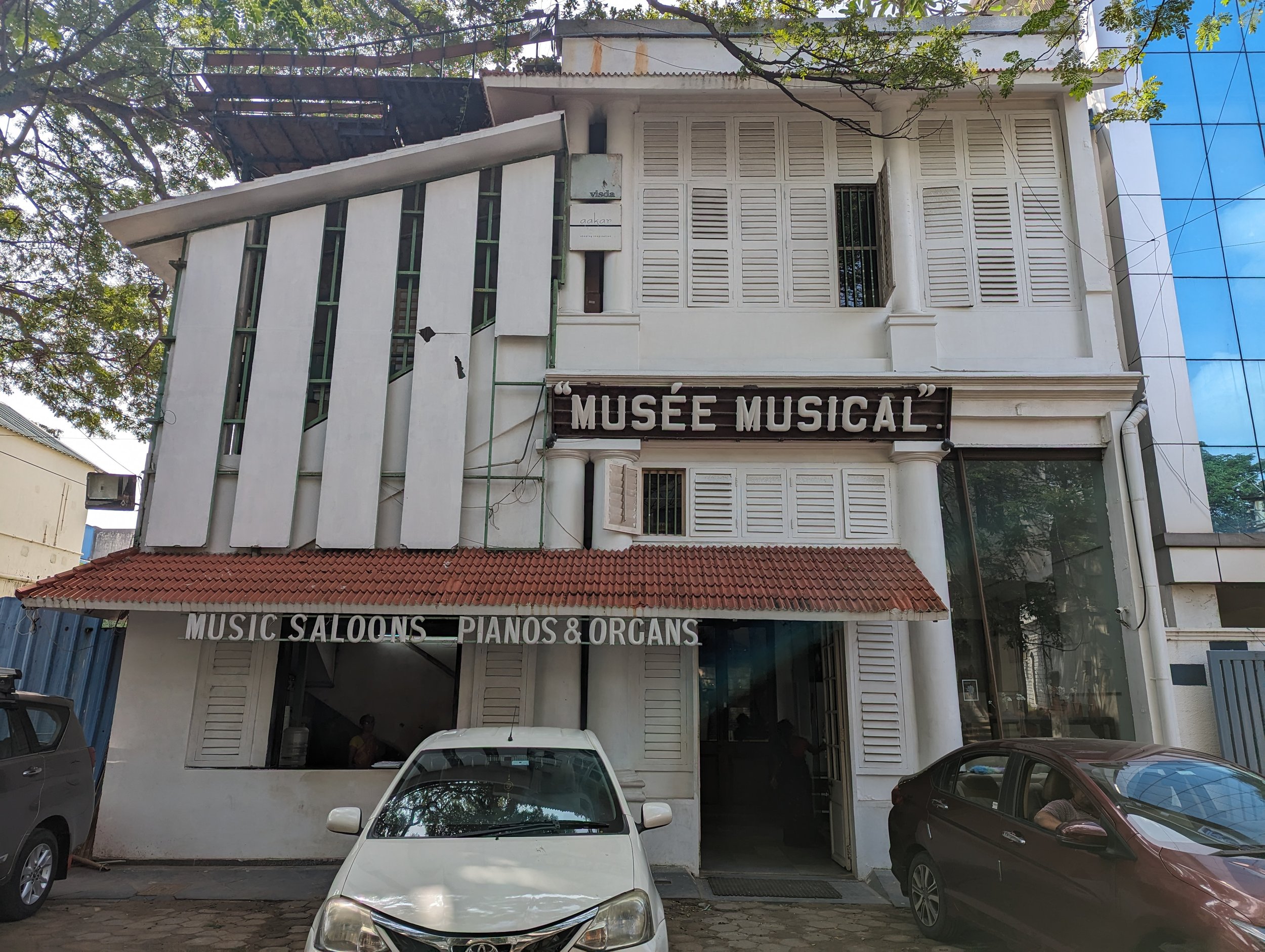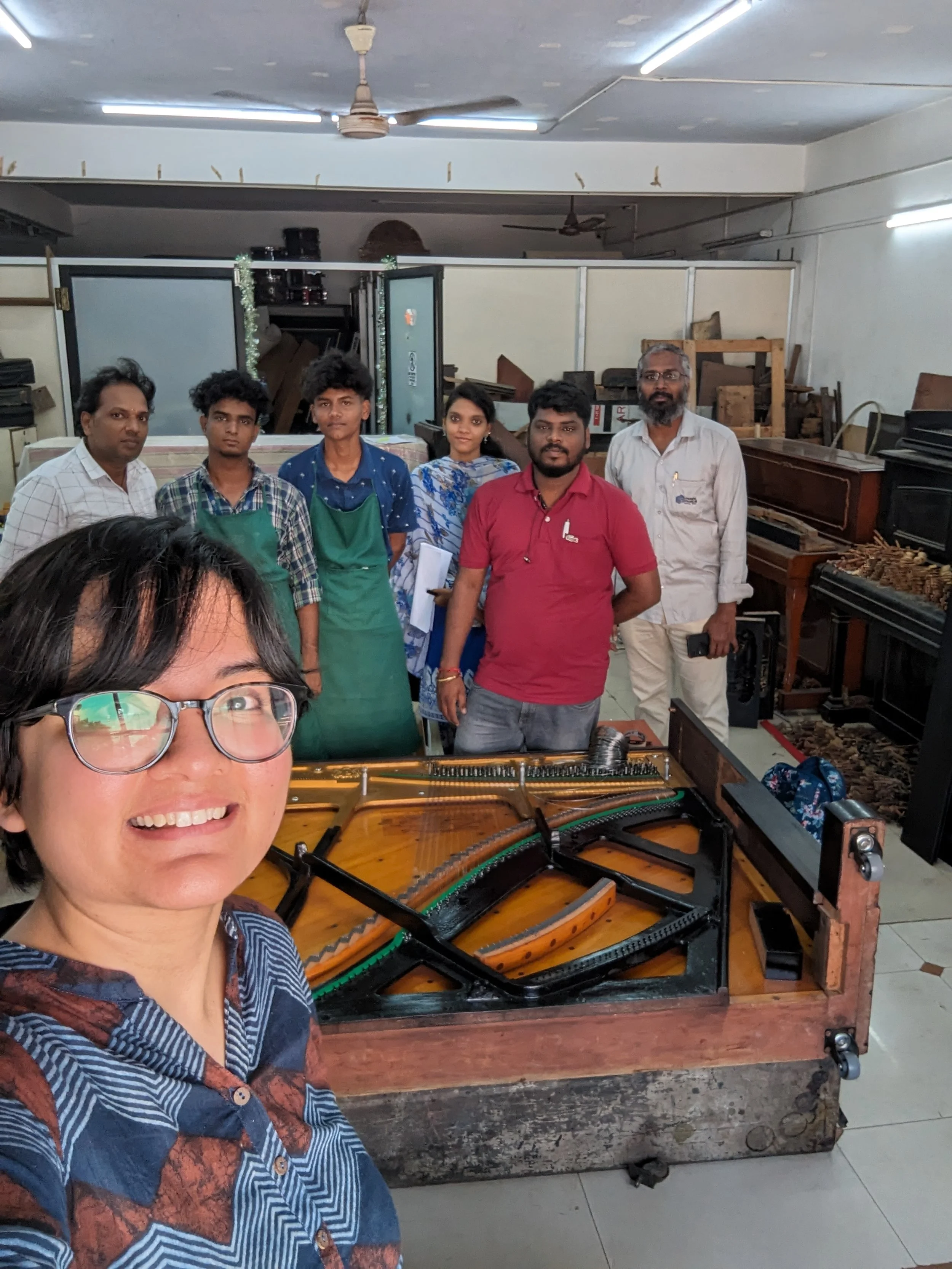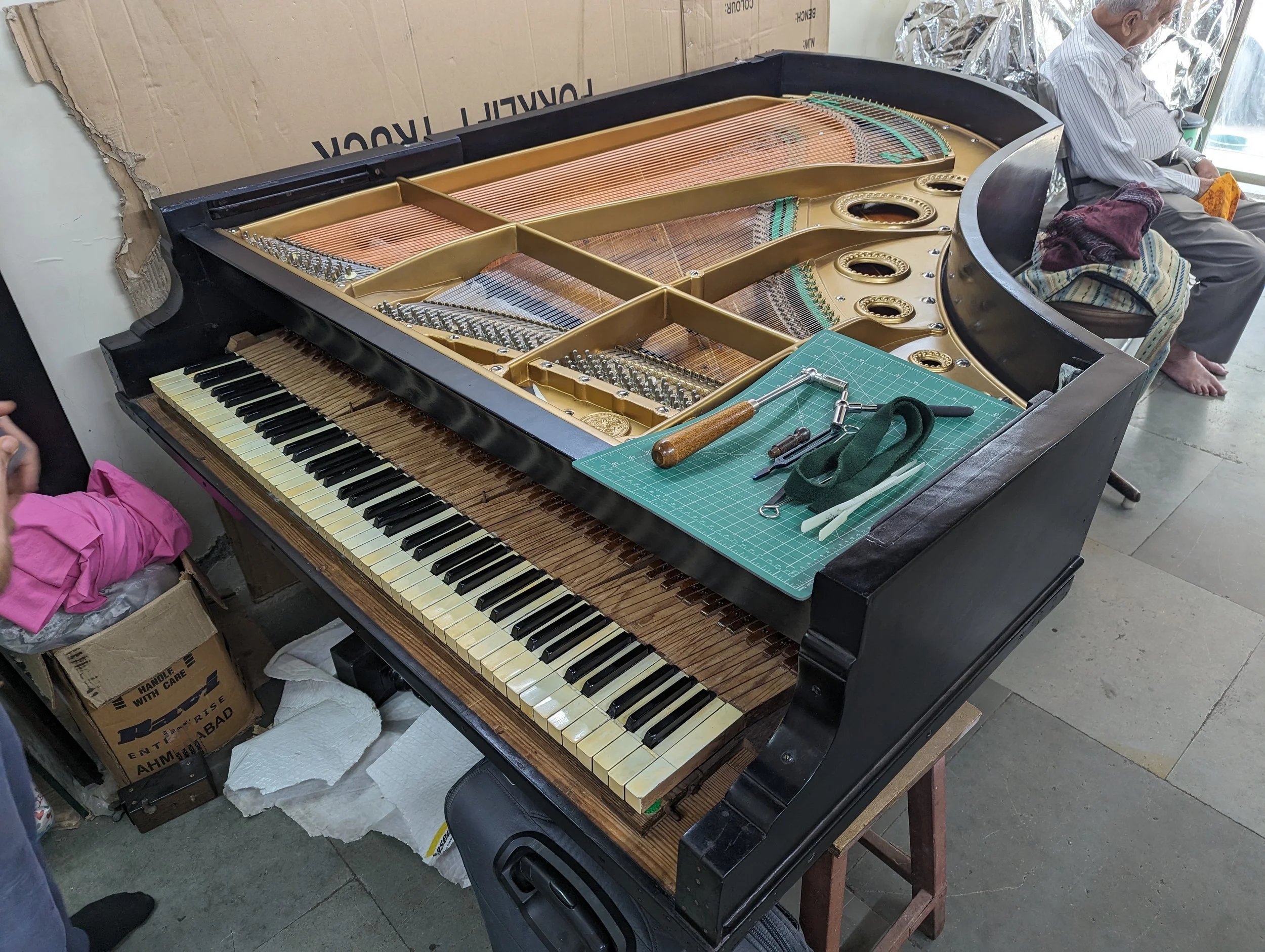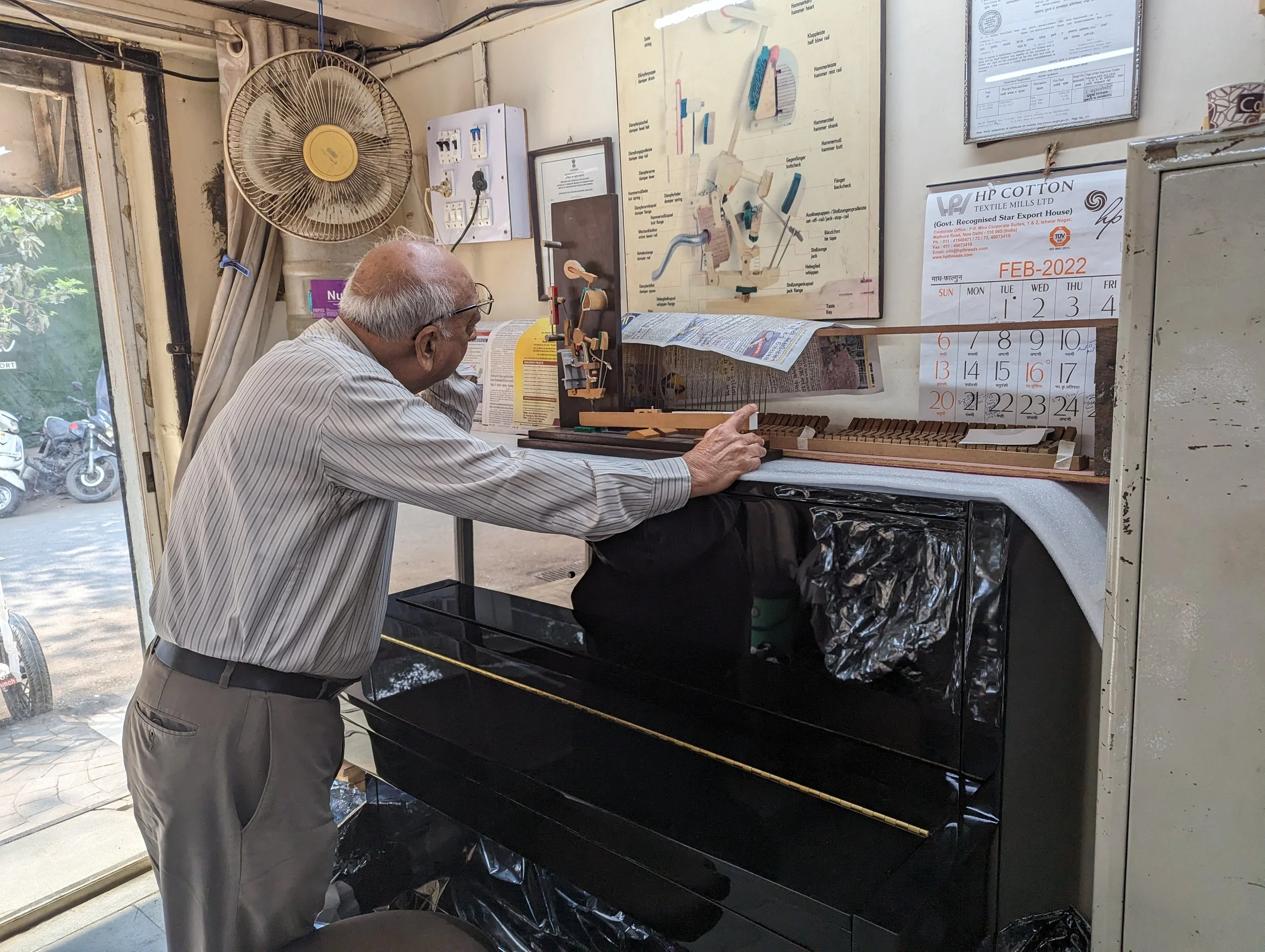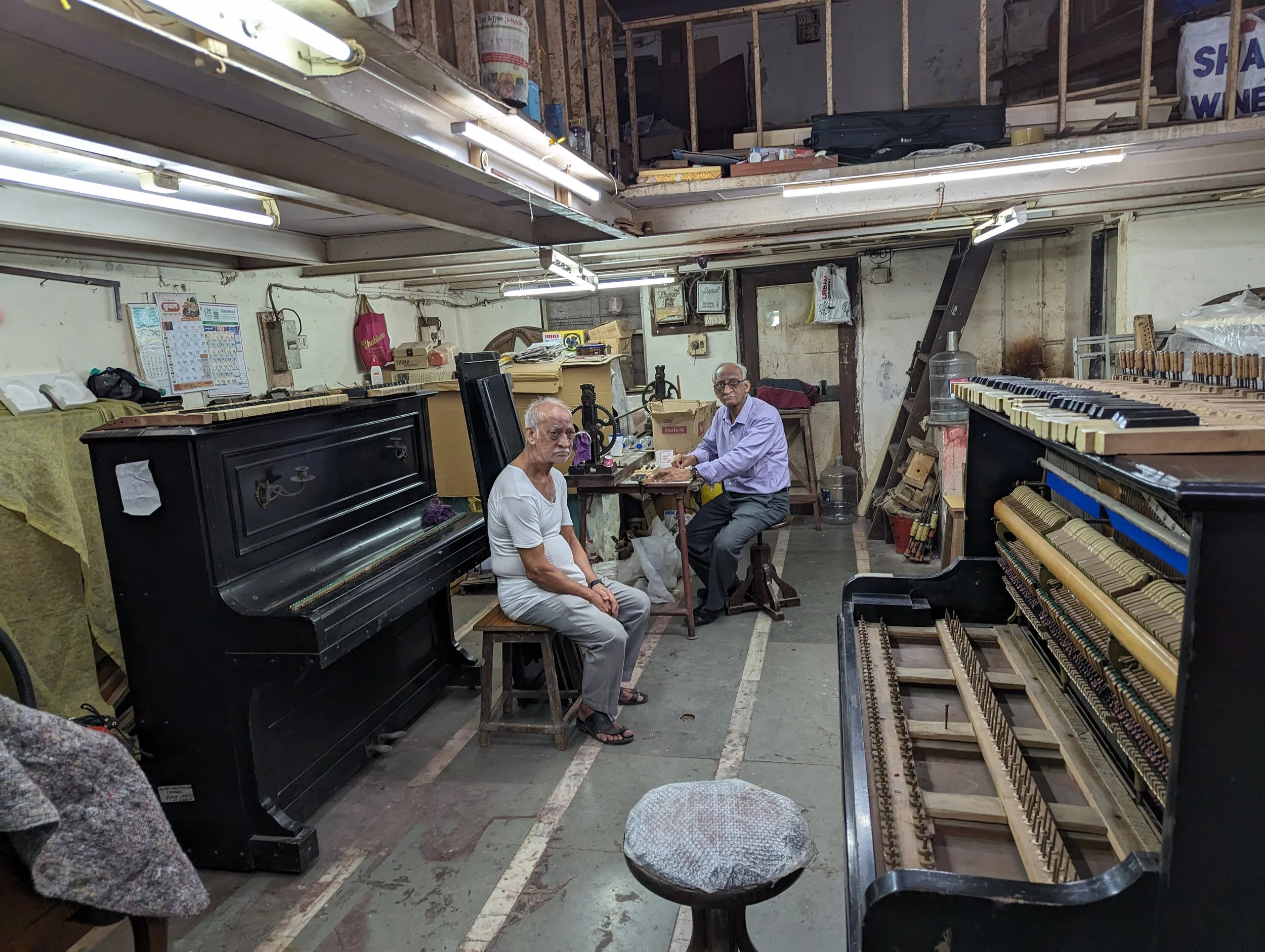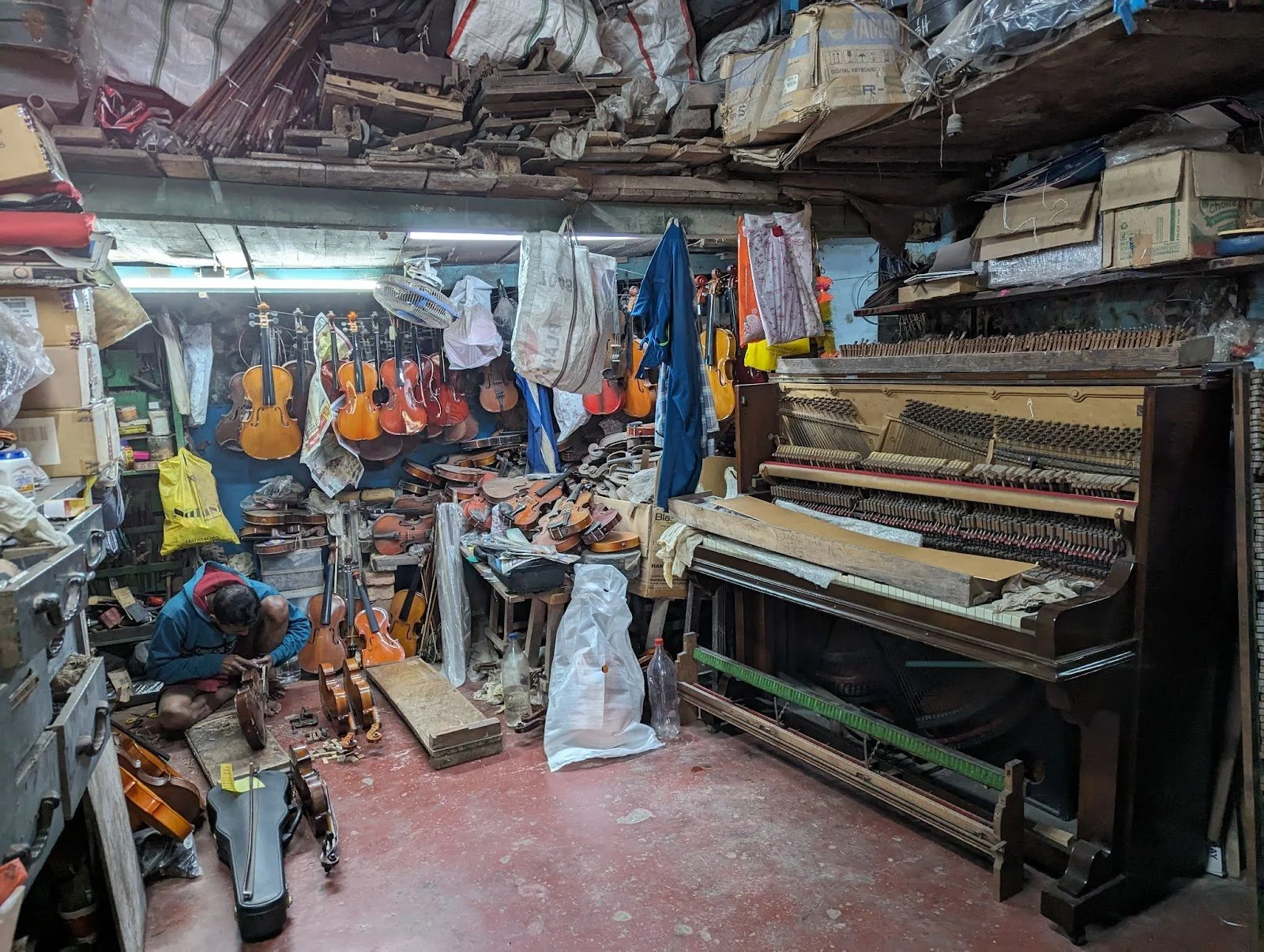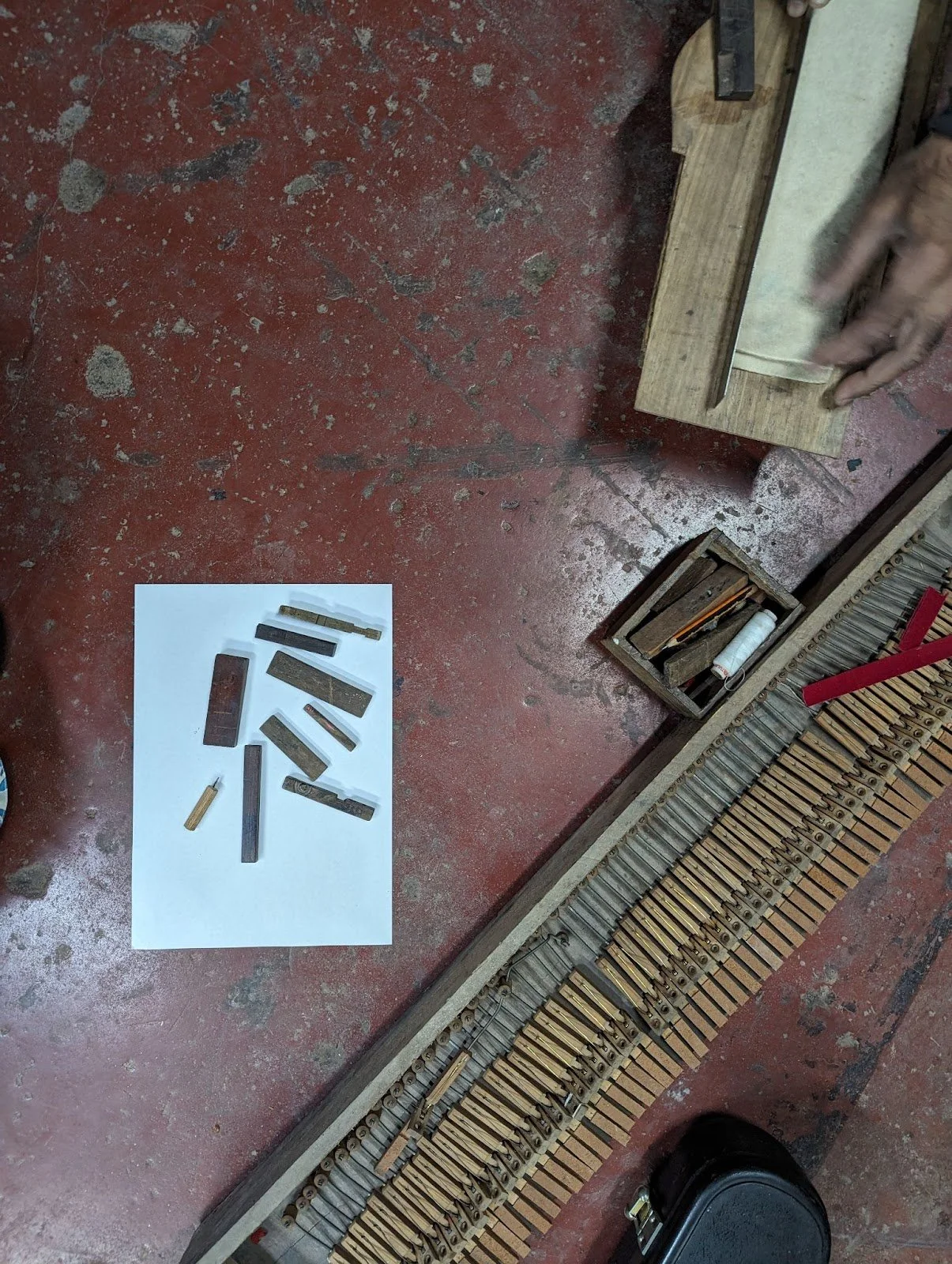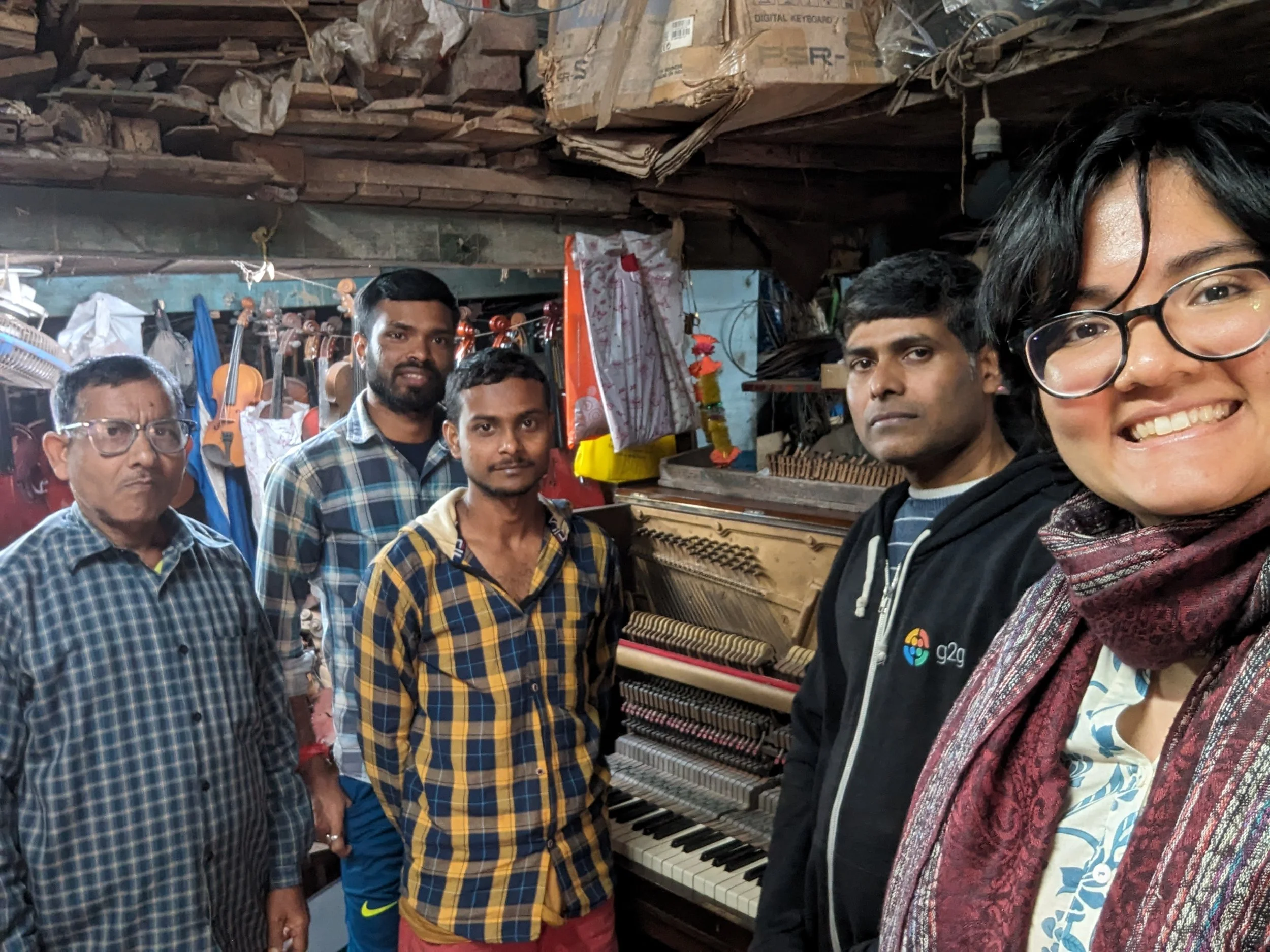Resonant Legacies – The Piano Tuners of India
Edinburgh | “No piano is junk. No person is unmusical.”
“Hello? Hi, is this a good time to talk? I’m Mirra. I’ve been learning to tune and repair pianos here in Edinburgh and I would really like to visit your workshop when I’m in India.”
Thus began a conversation with Ajay Mistry, the owner of Mistry & Co, one of India’s oldest piano tuning and repair companies. I was nervous. I didn’t know what to expect from the conversation. I had been lucky enough to be privy to the mysterious craft of piano restoration and tuning here, but my mind kept going back to the source of this interest - an old, small-built man hunched over my piano in Chennai, intently listening to sounds I only wished I could hear.
I would take every opportunity to watch Rao Uncle tune my piano at home, especially when it meant skipping a day of school. He would strike one key repeatedly, and somehow its sound would change each time. He would ask me to play when he was finished, which I would do very reluctantly – I didn’t know why it was important for his process. I just thought he, like many adults, wanted me to play a little tune since I was around a piano. Little did I know that he was probably listening more to the piano’s sound than my interpretation of a song. With a gentle smile on his face, he would take the time to compliment my playing before returning to the tuning pins only to change the sound again. And again. And again.
By this time I had been learning to tune pianos for little over a year. And by learning, I mean following piano technician Benjamin Truehaft around on his jobs and assisting him with the little I could do. In return, he would tolerate my constant bombardment of questions – a patient teacher if there ever was one, though he doesn’t agree – and eventually even handed me odd jobs from his customers (only to go back without a fret to fix the mistakes I had made). But even this would not have been an entirely fulfilling learning experience had it not been for the hundred odd pianos at my disposal that sat quietly in an abandoned shopping centre waiting to be rehomed.
A tuning lesson amongst all the pianos in an abandoned shopping center.
In January 2023, Pianodrome officially launched the ‘Adopt-a-Piano’ initiative to save and rehome the forsaken pianos of Scotland. I was fortunate to be part of the BBC interview that launched the initiative, and I spent my free time over the next few months trying to understand and tune as many pianos that came in ( I saved up and bought my first set of tools without having the faintest idea on how to use them – thankfully, I wasn’t the only one). Each piano had a different sound and personality through which I slowly began to understand the mechanics and architecture of this wondrous instrument. Under ‘Piano Doctor’ Joel Sanderson’s tutelage, we began to learn how to bring life and love back to the pianos… And so began my time as a building conservator on the weekdays and an amateur piano conservator on the weekends.
It took mere seconds for the Pianodrome to change my life, when I did a quick Google search to find out what three different cities in the UK had to offer outside of the postgraduate education I had just been accepted to. By the end of their YouTube video featuring a demonstration on how to dismantle a piano, I was in tears. My mother was sitting next to me when I was on my laptop pouring over their website, shaken by what I was reading about the team and their work – and in a trembling voice I said to her, “Amma… Look at this. This is where I need to be.”
So I moved to Edinburgh.
By some miraculous coincidence a new Pianodrome was scheduled to be built soon after I arrived, so I spent every chance I got at the warehouse dismantling pianos and making friends. I will never forget the first time I dismantled a piano… The deconstructed sounds of strings warping as I loosened them… The calculated kick that I was taught to get the side panels of a piano dislodged from the body… I had never kicked a piano before. I had never even removed the front panel to question what was going on inside it. Every activity simply shattered everything I thought I knew about myself and the instrument. It fundamentally changed me.
My first repair job – Redoing the felts and bridle tapes on this Bechstein upright that formed a playable piano of the Pianodrome
Ben putting me to work, unscrewing the action of a grand piano
Watching Joey inspect the action of a grand piano
A pint per tuning
“Eventually Everything Connects…”
One afternoon as I was perusing Canmore to look for historic photographs of Indian architecture (as one does), I chanced upon a photograph dated 1912 whose caption read: “H Hobbs & Co, 4 Esplanade East, Kolkata, lit for the British royal visit. The shop sat next to the Military (Ordnance) Department. Harry Hobbs (1864-1956) arrived in Calcutta to work as a piano tuner …”
All of a sudden a thousand thoughts collided in my mind. Memories of watching Rao uncle tune my piano merged with the thrill and wonder I felt when I used my own tools for the first time. I had to bridge my experiences, and the only way to do that was to go back to India and meet its pianos and their guardians. So when Ajay responded to my phone call with equal enthusiasm, I knew this was going to be my pilgrimage. I also knew that finding other piano tuners in the country was not going to be as easy a task, but I had a solid place to start – I just had to go back home to Chennai.
In preparation for my visit, I released a poster calling out for leads about piano tuners and technicians in India.
Chennai | “Meditations”
The first piano I met when I landed in Chennai was my own, a gorgeous Kawai upright that had sadly not been played in a few years. I unpacked my tools even before my toothbrush and went straight to work. It felt strange seeing its shiny body, bright white keys and plastic wippens – I had become so used to aging pianos. A quick condition assessment primarily revealed sticky keys and undone unisons, a result of the high humidity in the air. That morning, I used a hairdryer for the first time.
The next logical step was to contact Rao Uncle, and also visit Musee Musical, one of the oldest music shops in the country. Going back there brought back a lot of memories; it was where I got my first violin, performed in public for the first time, and attended all three of my piano exams. Cacophonic sounds of traffic from the main road slowly faded as I walked towards a colonnaded building with tall louvred windows. Shadows of trees danced on its off-white walls. Silence. I met Somu Ji at the entrance, who, bewildered by my request to “see where all the magic happens”, took me across to the opposite newer building, up two flights of stairs, down a narrow passageway and into the workshop – which also happened to be every injured piano’s journey.
Musee Musical, Chennai
I was surprised by the familiarity I felt in a space I had never visited before. Everyone in the workshop welcomed me as their own and I felt a deep connection with the people and the pianos. Veera the resident tuner restrung a restored Scheidmeyer upright piano while two apprentices arranged the wippens of another piano to the side. Nagaraj Sir, a quiet man with a permanent hint of a smile on his face, showed me around the workshop and described their work. He had started working in Musee Musical as a driver when he was offered the opportunity to fix pianos instead. More than a decade later, he is now the head piano and violin technician in the workshop.
The team at the workshop
While we began exchanging technical aspects of our learnings from the profession, it quickly became very apparent how little I knew about any of it; and so our conversation slipped instead into a reflection of our experiences with the instrument in two vastly different parts of the world. At one point, when I described how tuning had become a sort of meditation for me as a realignment of unison from discord, Somu Ji, Nagaraj Sir and Veera exchanged glances.
“You have to meet Sachin”.
Back to the old building, up the steps that reminded me of my nerve wracking Trinity piano examination days, and out onto a landscaped terrace where Sachin and a beautiful architecture studio welcomed me into the shade. A brief introduction later, I realized I was meeting probably the only other architect and piano tuner in Chennai, if not India. We spoke about a multitude of things, from our journeys in architecture and music to Musee’s school of music and outreach programs. What will always stay with me was how he also described tuning as his meditation. The exchanged glances made sense now. I felt heard.
A few days after my visit, I received a message from Somu Ji asking when I’d return. Our conversations at the workshop had given everyone a fresh energy and enthusiasm towards their work. I felt the same way, and carried this encouragement with me to Mumbai where I finally met Ajay.
A Chernihiv upright piano (~32 years) from Ukraine waiting to be restored
I would go on to visit my school in the following weeks to tune the upright piano that was donated to them the year after I graduated (I’m clearly over it). I barely opened up the piano’s body when children gathered around me playing the keys and looking in awe as the hammers struck the strings.
“Akka, why is it making that sound?”
“Wait it’s my turn to play now, you had lots of time!”
“Can I help you clean the piano? Wait da, you take out the keys and I’ll help akka dust underneath them.”
“Akka, why is that part moving so weirdly? When I press it down the sound goes on for sooo long.”
“It’s still not sounding good. Turn it a little more akka. Okay.. Now it’s better. It sounds like one note. You can stop now.”
It took me two days to tune that piano. But those were some of my most joyous days of being back in school.
Mumbai | “Observation helps to understand. Feeling helps to realize”.
‘A Mistry & Co – Complete Piano Service’ read the board that adorned an unassuming building along a narrow street in Bycullah. Bag of fruits in hand, I stepped into the shop and immediately, all the noise from outside ceased. A 1920s Bechstein grand piano took centre stage, partitioning the room into the showroom in front and a workshop behind. Cupboards were packed with custom made piano tools that I was lucky to handle. Ajay and I exchanged our stories and briefly, our tools. It didn’t take long for me to realize that mine were sub-par, considering the even weight distribution of the levers he had. Every aspect of a piano that needed fixing had a special tool to do so.
The shop in Bycullah
Ajay’s passion for piano tuning and restoration began as a child, when he would observe his father on the job. He worked with his father for years before undergoing formal training from the Grotrian Piano Factory in Germany. While his attention to detail and the meticulous nature of his work was inspiring, I was particularly struck by the calmness with which he responded to the surprises that the piano he was fixing threw at him. There was a deep reverence for the instrument regardless of the surgery performed on it, which reminded me of the joy and respect with which we pulled pianos apart at the Pianodrome. Sounds oxymoronic, but really, it isn’t.
Ajit joined us soon after. He was studying sound engineering, and apprenticed with Ajay when he could. They had just finished a job together in Pune. Witnessing this apprenticeship gave me so much joy – I could relate the informal yet sincere nature of our conversations that day with similar ones back in Edinburgh, and it washed away the notions I had about the nature of knowledge-sharing in India. It gave me a lot of hope about continuing to follow my passion for pianos wherever I was.
Ajay adjusting the screws holding the keyboard in place while Ajit observes
The real test of my knowledge took place in the evening, when Ajay asked me to tune the middle octave of an upright piano that was quietly standing in a corner. Unfortunately for me, the piano already sounded tuned which meant I had to listen to sounds that I had never heard before. Ajay introduced me to a new system of tuning, and gave me and Ajit a short lesson on the architecture of tuning pins and their movement within and outside the pin block. It made such a difference to the way I approached my own method of tuning. I realized that I have always associated piano tuning with the act of listening alone, but it has so much to do with the articulation of movement from one’s core to the arm to the hand to the lever through to the body of the pin, and in turn the string and pin block. Observing the movement of the tuning pin and actually feeling it yielded two very different learnings. I was nervous but determined to do well. I think I did – at any rate, I was able to recognise when Ajay sneakily detuned a string ever so slightly when I wasn’t looking. A nod of approval from him at the end was more than enough.
The Bechstein grand piano that we leveled
The next day I met Amritlal uncle, Ajay’s father and the 3rd generation piano technician in the Mistry family company. This 80+ year old man regaled me with stories of Maharajas and celebrities for whom he had tuned their pianos, and jokingly chided Ajay’s new age western approaches. With the promise to teach me “the true and correct” way of tuning when I returned, he left me to my masterclass on leveling the Bechstein’s keys. When I briefly turned back to speak to him, I witnessed a scene that I’ll never forget. Amritlal uncle stood by the piano I had partially tuned the previous day, and gazed at the model cross section of an upright’s action that sat on top of it. He pressed the key multiple times and watched as one small movement cascaded into another till the hammer struck the string. This moved me immensely – even after around seventy years of experience restoring pianos, he took the time to appreciate the fundamental principle behind the instrument and observe it afresh, almost in a state of play.
Amritlal Uncle in deep thought, observing the action of an upright piano
Ajit and I were invited over for lunch that day. Purvi, Ajay’s wife, made some of the tastiest food I’d ever eaten, and our conversations around food and the intention with which we cook and eat continues to stay with me, and has changed the way I consume food. They were incredibly welcoming, and just before we left, they changed my life once more – by introducing me to the paan goli, a tiny ball of delicious magic (I found my way to Crawford Market that evening just to get some more but I didn’t find the right one. Oh well, next time.)
Ajit, Ajay, Purvi, and me after one of the best lunches of my life.
Back at the shop, Ajay took me up the stairs to see their larger workshop in the building at the back. We passed by a number of industries till we arrived at the piano workshop on the second floor. More pianos in various states of restoration.. I wondered how many old pianos were still around – I had read about S.Rose and Co. pianos, which were made especially for the Indian market by Allison and Co. in Britain and exported to Bombay. I’ll confess this line of thinking had as much to do with the capacity to restore them as it was to seek opportunities to pitch India’s first Pianodrome. As it turned out, pianos were in abundance and mostly in use. They were also largely repaired, and at whatever cost. So would a Pianodrome work in India? Maybe not in the form of a 100 seater amphitheater made out of disused pianos. But in every other way, absolutely.
Pianos in different stages of restoration in the workshop upstairs
Before I left that evening, Ajay surprised me with a brand new bag for my tools, and two muting strips.
“Come back anytime!”
Kolkata | “Sirf tuning, tuning, tuning!”
My final stop was Kolkata, home of H.Hobbs & Co. My introduction to the city’s pianos was in the form of a delicious Rachals & Co. German grand at a hotel’s lobby. I surprised myself by asking the concierge if I could take a closer look (usually I would just stare in wonder and shyness from a distance – I’ve clearly evolved). As an even bigger surprise, he said yes. I opened the lid and there it was, written in metal relief work on the harp,
“Specially made for H Hobbs and Co, Calcutta”.
I introduced myself to the piano by playing my favourite piece by Ravel and quickly proceeded to find out about the instrument and its care. It was played during special concerts, and also every evening by a blind pianist who played for guests at the hotel’s reception. It was cared for regularly as well, by technicians from Braganza and Co. I noted the company’s phone number and tucked it away, as in that moment something far more important called out to me – Kolkata’s street food.
While the H.Hobbs and Co. building no longer existed, Braganzas stood not far off. It was a dream come true to witness this old building and its instruments resonate with one another. Solid timber rafters supported a roof that sheltered the instruments held by a red oxide floor. I met Tony and Nigel, the third and fourth generation owners of the music shop, and the first thing I asked was about their experience restoring Rabindranath Tagore’s piano. What a mind-bogglingly incredible thing to do. I also learnt that they had a system of renting pianos in order to make them more accessible to people, with some rates being a bare minimum even to this day.
An upright piano on a red oxide floor – a combination I never knew I needed in my life till now.
Turning left at the courtyard I entered the violin and piano workshop, where I met Pravat bhaiyya and his team busy at work. With the little Hindi I could manage, I introduced myself and requested if I could stay in the workshop for the day and help them out with anything. Pravat bhaiyya was thrilled. He had been preparing new key tops to stick on an upright piano, but paused briefly to show me around the workshop and the different pianos being restored with parts and tools, some made in Germany and others made in the workshop itself.
The workshop, and some hand cut measuring tools
Bhaiyya was extremely pleased that my interest lay in tuning. Ajay had previously insisted that tuning was only one part in the complex process of piano restoration and that I should focus my attention equally on the repair and regulation of pianos. Bhaiyya, on the other hand, insisted that everything else about piano restoration could be picked up on the job, and that I was to only focus on mastering my tuning.
“Sirf tuning, tuning, tuning”!!
A few years ago, Max Mueller Bhavan had selected two piano tuners from every state to go to Germany for two weeks for an intensive course on the restoration of pianos, as part of an incentive to bring German pianos to India. While some people benefited from this, piano tuners continued to be rare. Most of the masters were either really old or had already passed away (incidentally, the only other piano tuner I had researched about before going to India was Mr Sisir Das in Kolkata. I could not find a way to reach him; I even tried contacting a journalist who had written an article about him. It was bhaiyya who told me that he had passed away a few years ago, and was the head technician that had trained everyone at Braganza’s).
Convinced that I was not going to leave until I had tuned a piano, bhaiyya pointed to a particularly tired one. The tuning pins were very loose and I was met with incredulous smiles as I worked my way hammering them down and tuning the strings. At one point, reflecting on my job as a building conservator, bhaiyya said, “It’s the same isn’t it, be it taking care of pianos or buildings… We just have to properly use them and care for them, and they will automatically last longer and be happy”. I didn’t have the words to respond, so with a smile and acknowledgment that swept the room, we went back to work.
Home.
Each of us settled into a work like it was second nature. One person adjusted and tuned a violin, another person buffed the keys of a piano, a third person fixed the felts on to every wippen, and a fourth attempted to tune a piano. Our own silence as we worked was balanced by our instruments in conversation with each other.
The team of technicians at Braganza’s
Over the next few hours, I was fed at least seven small cups of tea, a delicious wrap, and a seasonal traditional sweet called Moa. What a lucky day. In the evening, just as I was about to leave, Pravat bhaiyya insisted I stay put so he could prepare something. Already overwhelmed by how much they were providing me, I wondered what more they could possibly want to give.
He handed me a little blue plastic bag, inside which was a mug with our photo printed on it.
“This is for you – to remember us, and to remember to keep tuning and working with pianos. You can come back here anytime. Just walk in, and do whatever work there is. This space is yours.”
Over the next few weeks Pravat bhaiyya and I would exchange pictures of the pianos we were working on and serial numbers to figure out their age. I really want to find a way to connect the technicians from Scotland/UK with those in India. Reader, if you have any suggestions, please let me know!
Here and Now | “Tat Tvam Asi.”
I never in my wildest dreams would have imagined interacting with the piano like I do now. The instrument may still be considered austere and unapproachable by a large number of people. The Pianodrome shattered that notion for me from the get-go. The piano’s reverence is in its use and exploration. How else can children’s excitement over seeing a piano’s action for the first time be explained? What else would make a master piano technician gaze silently at a model of the action, as if he’s still learning about it?
I was called a piano technician at the Pianodrome even before I knew what being a technician meant. It instilled a deep motivation in me to learn piano service and repair to the best of my ability and share the joys and wonder of it with others. Over a phone call days before returning to Edinburgh, Rao uncle gave me his blessings to take care of the pianos I come across in my life. I’m only at the beginning, but at least I’ve started.
I am truly indebted.
~
Dear reader, I am in search of a book written by Henry Hobbs about the pianos of India. It is titled ‘The Piano in India – How to Keep It In Order’. Please let me know if you come across it. A link to a previous auction below:
https://www.storyltd.com/auction/item.aspx?eid=4590&lotno=20
Mirra’s blog: https://paraasound.wordpress.com/

